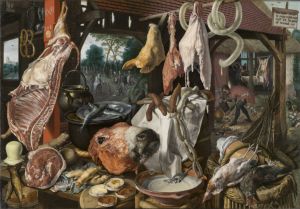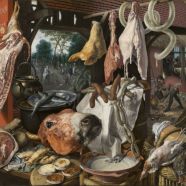A Critical Eye on Abundance in Art

Pieter Aertsen, A Meat Stall with the Holy Family Giving Alms, 1551. Oil on panel. North Carolina Museum of Art, Purchased with funds from Wendell and Linda Murphy and various donors, by exchange, 1993 (93.2).
Pieter Aertsen’s Meat Stall with the Holy Family Giving Alms is an enthralling and overwhelming scene of abundance. It is innovative in ways that might be difficult for today’s viewers to understand—before it was completed in 1551, for example, there was no such thing as a still life painting in the Western tradition. There were still life elements in art, of course, but featuring a meat stall as the primary subject of such a large oil painting was unprecedented.
Why was that? In most of Christian-dominated Europe (specifically Catholic Antwerp in present-day Belgium, where Aertsen was working at the time), paintings were supposed to have an educational, spiritual component. They were, in other words, meant to have a positive impact on their viewers and not just be beautiful or interesting for their own sakes.
There is no mistaking that the main subject of Aertsen’s painting is the various meats, cheeses, and other comestibles artfully arranged across the foreground. First and foremost, these objects showcase Aertsen’s skill—his mastery of textures as diverse as wood, cloth, cheese, reeds, feathers, fat, and flesh—as well as his ability to create an illusion of three dimensionality and depth in paint on a flat wood panel. Beyond this, though, Aertsen cleverly inserts narrative elements into the background of his painting that give additional meaning to his still life and are a preemptive answer to those who might have found this work to be too secular. Through the central opening of the meat stall, we see a vignette of the Holy Family giving alms on their flight into Egypt, which is a rare subject for artists of this period.
With abundance comes the danger of excess, and in response Aertsen balances the food for the body in the foreground with food for the soul (charity) in the background. This is further contrasted with the scene of a rowdy tavern interior, at back right. This might be an image of the parable of the prodigal son—itself a condemnation of excessive indulgence—but in any case, the mussel and oyster shells littering the ground in front of this tavern demonstrate the licentious and sinful behavior that can result in an overabundance of material goods.
That Aertsen’s painting was successful, famous, and influential in its own day is proven by the fact that this work is one of at least four sixteenth-century copies. The North Carolina Museum of Art’s version, however, is Aertsen’s original. Conservation imaging of the painting revealed a drawn underlayer, a design that was sketched onto the panel by the artist to follow as he started painting. This underdrawing is key to understanding Aertsen’s artistic process and the relationship of our painting to the other versions; in this case it was not followed exactly in the finished painting. This means that the artist experimented with the composition and that the final design was not set, as is the case with the other existing versions.
Aertsen’s painting was completed just before a revolt that put his native Netherlands and what is now Belgium at war for eighty years and led to, among other things, a division of artistic activity and the migration of artists along religious lines, with Protestants in the north and Catholics in the south. It is an unprecedented example of the artistic innovations of northern Europe and marks a unique moment in the artistic and cultural history of this region. This painting came to the North Carolina Museum of Art in 1993 and has remained one of the most fascinating, significant, and unparalleled works in our collection ever since.







